Table of Contents: Intro & 1920; 1921-1923; 1924-1927; 1928-1932; 1933-1935; 1936-1939; 1940-1945; 1946-1949; 1950-1953; 1954-1956; 1957-1959; 1960-1963; 1964-1966; 1967-1969; 1970-1973; 1974-1976; 1977-1979; 1980-1983; 1984-1986; 1987-1989; 1990-1993; 1994-1996; 1997-1999; 2000-2003; 2004-2006; 2007-2009; 2010; 2011; 2012; 2013; 2014; 2015; 2016; 2017; 2018; 2019; Recap & 2020; 2021; 2022
This week, the 100 Years of Buggy History series takes a look at the early 1950s. The rise of Soapbox Derby-style racers with derby wheels took DTD to a fivepeat before the 3rd greatest winning streak of all time got underway, but only by a whisker. Plus, Buggy initiates an entry fee, allows multiple buggies for the first time, and adds brakes!
1950
Raceday: Prelims on Friday, May 12 at 10:00am; Finals on Saturday, May 13 at 1:00pm
Sweepstakes Committee: Pat Ryan (Chair)
Race Results: (1) DTD (2:41.8 – COURSE RECORD); (2) PiKA; (3) DU; (4) ATO
Design Comp: (1) KapSig; (2) SAE
Weather: Cloudy, 54-61 Degrees on Friday; Mostly Cloudy and Windy, 70-71 Degrees on Saturday
The start of the decade didn’t change much about the results, but it did bring about a couple of administrative changes for participants.
- Pay To Play. Based on a letter to the editor in 1950, it seems that in years past, entry into Buggy was free for organizations; the time expended in putting together a buggy and team was considered enough. But in 1950, the Spring Carnival Committee decided to improve the financial status of Spring Carnival, and with that came an entry fee for Buggy (as well as for the float parade). We don’t know how much the entry fee was in 1950, but the fee in 1951 was $7.80 (roughly $83 in 2019 dollars), so it was probably something similar.
- Design Comp Judging Change. Another change in 1950 affected the process for how Design Comp winners were determined. A new scoring system was put in place in 1950 similar to the scoring system for Booth or Greek Sing. Each of 3 judges scored each buggy out of 100 points, based on the engineering and aesthetic qualities of the buggy. The 3 scores would be combined, and the buggy with the highest total score would be declared the winner (as long as the buggy finished the race).
- 2-Team Heats. For years, organizations had complained that they were at a disadvantage if they were in Lane 3, because they were forced to take a wide route around the traffic dummy at the top of Hill 2. In the past the workaround was that Lane 3 was given a 3 yard head start. But in 1950 the complaints had reached a boiling point, and Sweepstakes decided to ignore Lane 3 for Prelims entirely. Instead, they decided to run the 14 organizations in 7 Prelim Heats with 2 teams each.
- Results. We don’t know too much about the race. What we do know is that the 3 teams advancing to the Finals were DTD, PiKA, and DU. KapSig would have made it to the Finals, as their Prelim time was a course record 2:39, but they were DQ’d for a Hill 1-2 transition violation – the Hill 2 pusher began pushing before the buggy had reached the transition zone. DTD was victorious in the Finals, setting a course record with a final time of 2:41.8, with PiKA finishing 2nd and DU finishing 3rd.
- KapSig Takes Design. KapSig did get some redemption, however, as they earned the victory in Design Comp. Their buggy, designed by Bob Bertelsen, earned 187 out of the maximum 300 points. SAE supposedly built a new buggy in 1950 that was “better” than its design winner in 1949, but the new one was only able to take 2nd place. [Ed. Update – We’ve identified what we believe is the SAE buggy (#6), and it looks pretty similar to the 1949 buggy, so it might not have actually been “better”…]
- 1950 Photos. We’ve got plenty of photos from 1950, though we don’t have all of the buggies ID’d, so let us know if you know one we’re missing!
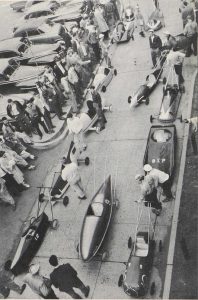
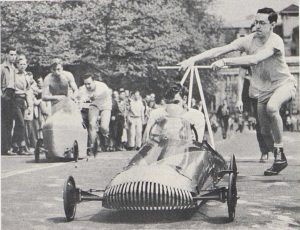
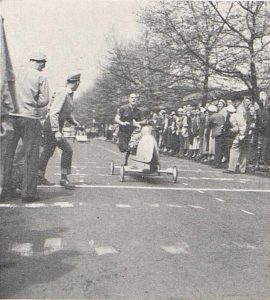
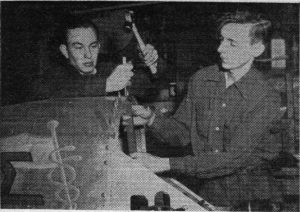
1951
Raceday: Prelims on Friday, May 11 at 10:00am; Finals on Saturday, May 12 at 10:00am
Sweepstakes Committee: Emerson Pugh (Chair)
Race Results: (1) DTD (2:41.6 – COURSE RECORD); (2) KapSig (2:54); (3) DU
Design Comp: (1) KapSig; (2) SAE
Weather: Drizzling Rain, 60-61 Degrees on Friday; Partly Cloudy, 49-61 Degrees on Saturday
1951 saw a rainy Raceday lead to some interesting photos and a blowout race. But there wasn’t much of a worry because of one other major change – the addition of brakes.
- Stop the Presses – Major Rule Change. One of the most significant rule changes in Buggy history came about in 1951. For the first time ever, all buggies were required to have braking systems. We don’t know why this rule was instituted in 1951, but it’s not hard to imagine a situation that could have prompted the new rule.
- Push Practice Becomes Official. Practicing for Raceday in off-campus locations became a thing of the past in 1951, as push practices became official. Teams were permitted to practice on the Buggy course from 11:00pm-12:30am, Monday through Friday, beginning on April 30 (2 weeks before Raceday). It’s unclear if this was just the hills or the full course, but police protection was provided to the organizations. Of course, the side effect of having official practices meant that any team caught practicing on the course outside of the designated hours would be disqualified from Raceday.
- Eligibility Rules. Another new rule in 1951 made it so that students on probation (presumably this means academic probation) were ineligible to participate in Buggy. The May 8, 1951 Tartan notes that since this rule also applies to IM sports, Buggy has essentially been elevated to the rank of IM Sport. The Tartan says that this is no surprise, as “the annual grunt and groan derby with the [buggies] requires as much time and effort as any IM sport. The mankiller push up the [Front Hills] is the equivalent of any football game.”
- Spectators Get More. We previously covered the early broadcasting attempts on the course, which involved a PA system and a starter in one of the trucks. But in 1951, the broadcast was expanded to something a little more useful for spectators. 4 walkie-talkie announcers were stationed around the course, all being controlled by a central broadcasting unit. This allowed spectators to receive a full picture of the race (and isn’t all that different from how things are handled today).
- Multiple Finals Heats. With 14 organizations, the 1950 model with 7 Heats of 2 teams each, rather than 4 heats of 3 and 1 heat of 2, made more sense, so that was repeated in 1951. The Finals, however, were expanded from 3 teams to 4, creating, for the first time (as far as we can tell), a multi-Heat Finals. Finals Heat 1 was set to be the 3rd and 4th fastest times from Prelims, and Finals Heat 2 was the fastest and second fastest times from Prelims. The results would then be determined the same way it is today; the fastest time of the 4 would be the winner.
- Race Details. Of the 14 organizations (12 fraternities, Citcom, and Men’s Dorms), the 5 favorites heading into the race were DTD, KapSig, PiKA, DU, and Beta. And those favorites didn’t disappoint. On the soggy course, DTD, KapSig, and DU all advanced to the Finals (we’re not sure who the 4th team was). PiKA would have made the Finals with the 4th fastest time in Prelims, but they were DQ’d for a transition violation. The only other notable occurrence came from Citcom Clan, whose pushbar handle broke off immediately upon being pushed off the starting line, leading them to be DQ’d as well (I assume for a loss of mass). We don’t know the Finals Heats, but we do know that DTD won the race with another course record, this one a 2:41.6, with KapSig 12 seconds behind in 2nd and DU 3rd.
- Design Complaints. KapSig once again took home the Design Comp trophy, which was uncontroversial. However, a letter to the editor published in the May 22, 1951 Tartan complained about some of the other buggies entered, arguing that the designs were not built to race and shouldn’t be honored. The writers, Thomas M. Birch and Sellers B. McNally (E’52) (both from DTD), complained that the judges were unknowledgeable about the engineering aspects that make a good racing buggy, and that the judges typically rewarded complexity that wasn’t necessarily practical and favored aesthetics over aerodynamics. Speaking about a particular buggy (it’s unidentified in the letter), the writers say that “Perhaps if the buggy that has really NEEDED the rear view mirrors for the past four years [Ed. note – This might be KapSig (see photos from 1950 above) or ATO (see the 1949 photo from last week)] had incorporated a cigar lighter, a sliding cockpit cover, parking lights, and a Buick grill, it, too, might have placed in the Design Awards.” The letter suggests that a rule should be made that a buggy must finish in the top half of the race to be eligible for the Design Competition, rather than just finishing at all. It looks like the 1952 Sweepstakes Committee may have paid attention to this…
- 1951 VIDEO. We’ve got a video from Raceday 1951! You can watch the 13 second footage here:
- 1951 Photos. Some photos from 1951:

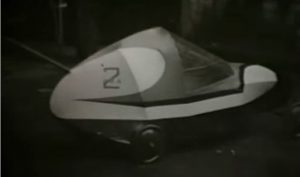
1952
Raceday: Prelims on Friday, May 9 at 10:00am; Finals on Saturday, May 10 at 10:00am
Sweepstakes Committee: Ray Mangold (Chair)
Race Results: (1) DTD (2:36 – COURSE RECORD); (2) KapSig; (3) PiKA
Design Comp: (1) KapSig; (2) SigNu
Weather: Mostly Cloudy, 60-65 Degrees on Friday; Cloudy, Possible Rain, 67-69 Degrees on Saturday
1952 saw DTD pick up its 5th straight win and brought about a rule change for Design Competition.
- New Design Qualification Adopted. The Letter to the Editor from 1951 clearly struck a nerve among the general Sweepstakes body. Sweepstakes changed the Design Rules in 1952, so that in order to qualify for the trophy, a buggy needs to finish in the top half of the race.
- Miscellany. We don’t know a ton about 1952, but there are a few random things that I’ll throw together. The entry fee was $7.50 per organization. DTD was once again the favorite to win, with their buggy that weighed 134.5 pounds. After a couple of years of 2-team heats, Sweepstakes once again decided to run full 3-lane heats. And once again, a “sound truck” was travelling the course with the buggies in order to broadcast the races to the spectators who were unable to see the full thing.
- The Tartan “Enters” A Buggy. Since there isn’t much to say about the actual Raceday, I’ll share this story from the May 6, 1952 Tartan. Apparently, the Tartan staff was tired of the slow buggies on the course, and so they decided to build and enter their own buggy this year! The sleek, needle-nosed supersonic buggy was designed to travel at a maximum of 150 miles per hour, helped along by frictionless pulleys to be used as wheels (thanks to knowledge learned from a trip to Saturn). The buggy, painted like the XF-791 Air Force rocket ship, had a cockpit upholstered with Australian Alligator skin, and holes were drilled in the side of the buggy so that when the wind blew, the buggy played Fight For The Glory of Carnegie. The most interesting thing about this outrageous story though? It was the only full article on that page (taking up ¼ of the page)!
- DTD’s Run Continues. For the fifth year in a row, DTD earned the victory, setting their third straight course record and putting up the first official sub-2:40 time.
- 1952 Photos. Even though we didn’t have much in the way of stories from 1952, we do have some photos!
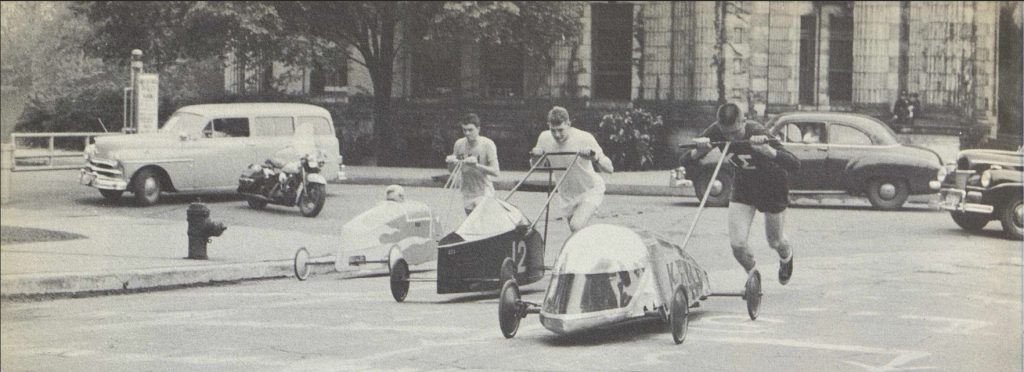
- 1952 VIDEO. We’ve got a video of the 1952 Finals!
1953
Raceday: Prelims on Friday, May 8 at 9:00am; Finals on Saturday, May 9 at 10:30am
Sweepstakes Committee: Al De Vido (Chair)
Race Results: (1) ATO (2:30.55 – COURSE RECORD); (2) DTD (2:30.6); (3) PiKA
Design Comp: (1) PhiKap; (2) DTD
Weather: Cloudy, 50-56 Degrees on Friday; Sunny, 65-72 Degrees on Saturday
It took a new course record and a photo finish, but 1953 saw a changing of the guard as ATO kicked off their record-setting run, plus the ability to enter multiple buggies.
- Multiple Buggies Allowed. For the first time in Buggy history, orgs were allowed to enter 2 buggies, rather than just 1. The entry fee was $8.44 per buggy. Overall, only 2 fraternities, ATO and DTD, took advantage of the new rule. 15 buggies were entered, as the additions of 2 ATO and DTD buggies replaced the Citcom buggy (which did not enter).
- Carnival Gets Big…Too Big? In the first (that I saw) of what would become many over the years, an editorial in the May 19, 1953 Tartan questioned Spring Carnival and whether it was getting too big. The argument was basically that the students spend too much time, effort, and money into planning and building the various Carnival events (Booths, Floats, etc.) which essentially turned what was supposed to be a fun break into more work than school (crazy, right?!). The article exempts Buggy from this criticism, however, because Buggy somehow “seems to be a worthwhile project”.
- Prelim Heats. We don’t know much about the specific results in the Heats, but we do know what those heats were. Competing in Heat 1 were KapSig, DU, and PhiKap. Heat 2 was Tau Delta Phi, ATO (1), and the Men’s Dorms. Heat 3 was SigNu, Beta, and DTD (1). Heat 4 saw SAE, ATO (2) and PiKA. And Heat 5 consisted of DTD (2), Theta Xi, and Beta Sigma Rho. The 3 fastest times came from ATO, DTD, and PiKA (I’m guessing, with no real basis, the buggies in Heats 2, 3, and 4). In fact, both ATO and DTD were so impressive that each broke the previous course record of 2:36, and both orgs went into the Finals with a good shot at the trophy.
- ATO’s Reign Begins. ATO went from an also-ran to a major player in 1953. How? They decided to build a new buggy that was a carbon copy DTD’s #12. The decision to build that buggy, which would come to be known as “Andy 1” (named after the father of ATO brother Don “Ace” Adams, who was a Carnegie Tech employee and good friend and ally of ATO), paid off in spades. The 2 orgs were neck-and-neck the entire race, but ultimately ATO nosed out DTD by less than 1/10 of a second and destroyed the previous course record, earning their first of what would become a record-setting victory streak. But drama followed behind those two buggies.
- Finals Drama. The excitement of the Finals may have come from ATO and DTD on the front end, but there was plenty of drama behind them as well. The two were so close throughout the race, and spectators were so caught up in it, that the crowd raced to the Back Hills and the Finish Line to see who would win. Unfortunately, lost in the neck-and-neck battle between ATO and DTD was the fact that the Finals heat actually included 3 buggies. PiKA, who had fallen behind the other two, was still racing, but spectators seemed to forget. The spectators crowded the course on the Back Hills to see who would win the battle upfront, and PiKA’s buggy ended up crashing into one of the spectators, injuring that member of the crowd and knocking their buggy out of the race.
- 1953 Photos. Below are some photos from 1953.

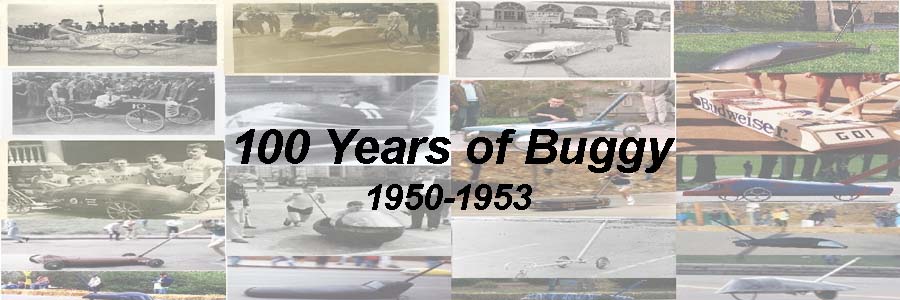
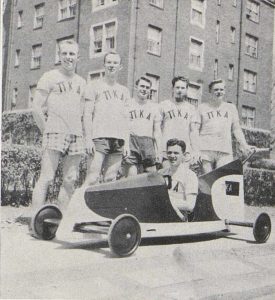

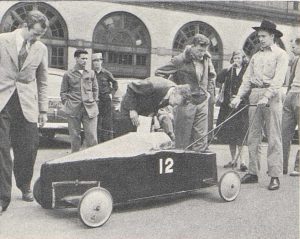
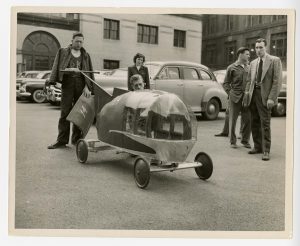
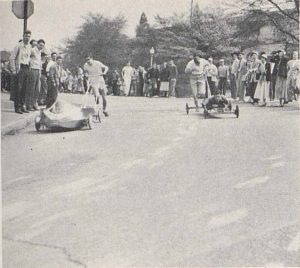
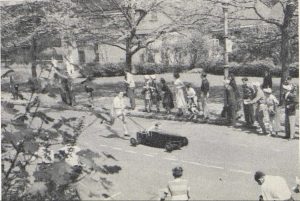
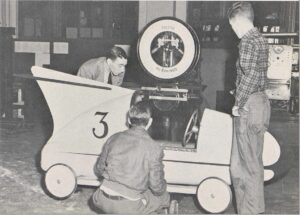
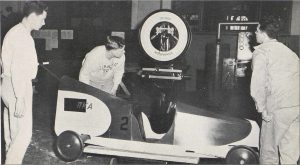



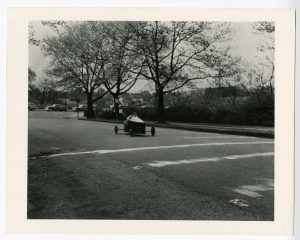


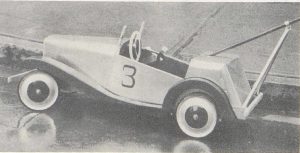
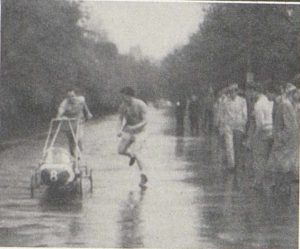



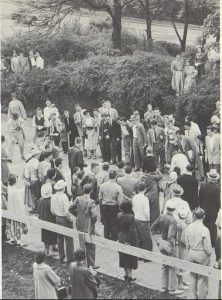
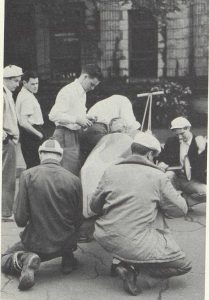
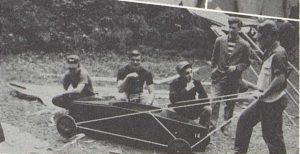

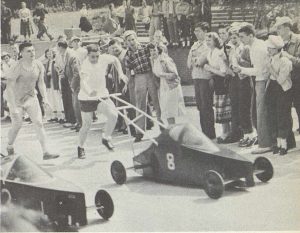
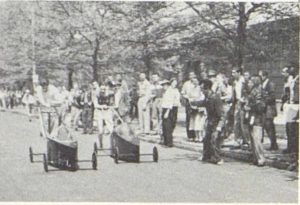
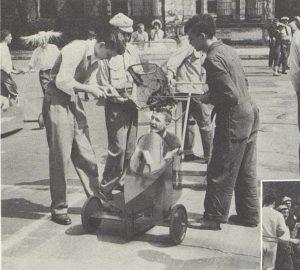
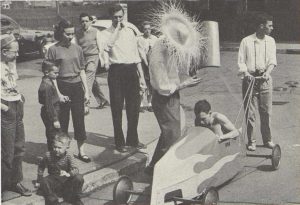
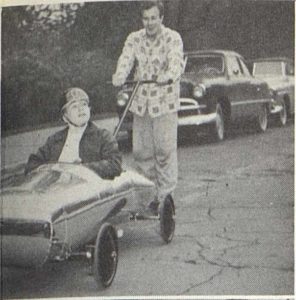
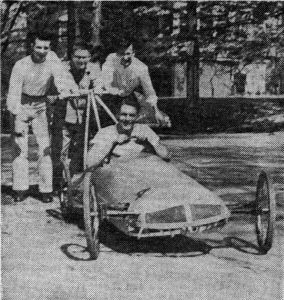
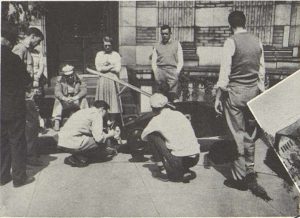
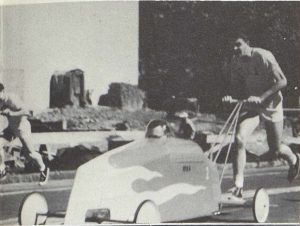
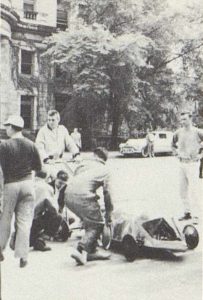
Aileen says:
I’ve really been enjoying this series! Great job, guys.
Ben says:
Bryan has really been kicking it up a notch for the occasion!